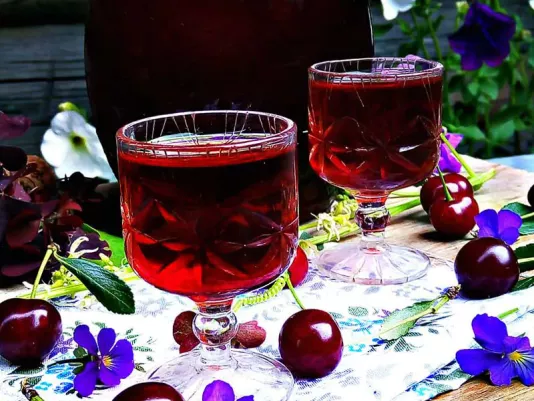Black Forest Cherry Cake
Black Forest cherry cake – German cuisine recipe, airy, delicate and very tasty cake with cherry liqueur.

Cherry Liqueur is something I first began making when I wanted to preserve the cherry harvest in a more refined form than jam or compote. Over the years, I realized that this drink could be not only a decoration of the festive table but also a subtle culinary accent. In my practice, it has often helped create dishes with a rich flavor profile: from delicate desserts to meat sauces. I always carefully choose the cherries: overly ripe ones give the liqueur heavy sweetness, while slightly tart ones create a more expressive balance. In preparation, I learned to account for the ratio of sugar, alcohol base, and infusion time. An incorrect balance can spoil the result: too much sugar makes the liqueur cloying, while too short an infusion makes it shallow. For me, this process became an art where experience, attentiveness, and patience all matter. Thanks to this, cherry liqueur always turns out deep, aromatic, and complete.
Over the years, I realized that the choice of fruit determines the quality of the liqueur. The best are juicy, dark-red cherries with a rich aroma and no damage. I always choose cherries with fresh stems, as this indicates freshness. If the cherries are too soft or have spots, the drink may develop an unpleasant taste and cloudiness. For liqueur, I like to combine sweet and sour varieties: sweet ones add softness, while sour ones bring expressiveness. I also noticed that cherries picked in dry weather provide a more concentrated flavor than those harvested after rain, as moisture dilutes their juice. In my practice, I always sorted the cherries by hand, selecting only the best, since even a few spoiled ones could ruin the whole batch. The right choice is not only about aesthetics but also a guarantee of balanced flavor and clarity of the drink.
In my practice, preparing the fruit is the key to the deep flavor of liqueur. I always wash the cherries thoroughly and remove the stems, but I often leave the pits: they add light astringency and a distinctive almond note. It is important to remember that infusing too long with pits makes the taste bitter, so I always control this process. For infusion, I use glass containers, as metal or plastic can affect the aroma. I cover the cherries with sugar and leave them for a few hours to release their juice, then pour in quality alcohol – usually vodka or brandy. In my experience, the ratio of fruit to alcohol is critically important: too much alcohol suppresses fruitiness, while too little fails to provide the needed strength. I let the liqueur infuse in a dark, cool place for several weeks, shaking the container occasionally to distribute the flavors evenly. This process requires patience, but it is what forms a rich and balanced result.
In my practice, I found that even in liqueur preparation, temperature matters. If I make a hot syrup to dissolve sugar, I always bring it to a boil and remove it immediately to avoid caramelization, which can spoil the flavor. I cool the syrup before adding it to the infusion, since too high a temperature can ruin the fruit aroma and alter the drink’s structure. In cases when I use pasteurization for long-term storage, I strictly maintain a temperature of 70-75°C (158-167°F) to preserve the flavor and prevent the loss of vibrant color. I noticed that even a few degrees’ difference can affect the outcome: too high a temperature makes the liqueur dull, while too low does not ensure safe storage. That is why I always watch the thermometer carefully and do not rely solely on intuition. Such control allows me to obtain a liqueur that preserves both flavor and attractive appearance.
In my practice, cherry liqueur became a versatile component for creating desserts and drinks. I often use it to soak sponge cakes: it adds a delicate fruity note and makes the cake moister. In creams, a small amount of liqueur adds sophistication, especially when combined with dark chocolate or coffee. I also add it to fruit salads along with citrus juices – this creates a rich and harmonious flavor profile. In meat sauces, cherry liqueur opens up a new level: combined with wine or balsamic vinegar, it develops a deep aroma and a pleasant balance of sweet and sour notes. In cocktails, it works as a vivid accent that pairs easily with sparkling wine or light spirits. Over the years, I realized that the key is not to overdo it: too much liqueur makes the taste cloying. Moderation is what allows me to create dishes and drinks where the liqueur highlights rather than dominates.
Over years of preparation, I have seen many mistakes that are easy to avoid. Most often, too much sugar is added, and the liqueur becomes overly sweet, losing its fruity freshness. Another common issue is using low-quality alcohol: instead of a deep taste, it gives a harsh alcoholic note that overpowers the fruit aroma. I always insist that the base must be clean and of good quality. People also often ignore infusion time: rushing makes the liqueur shallow and lacking aroma. Another mistake is storing it in light: this leads to loss of color and spoiled taste. In my practice, quality control means attentiveness to every step: from selecting fruit and balancing ingredients to conditions of infusion and storage. Only this way can you achieve a drink that is not only delicious but also refined, worthy of the festive table and the most demanding gourmet.